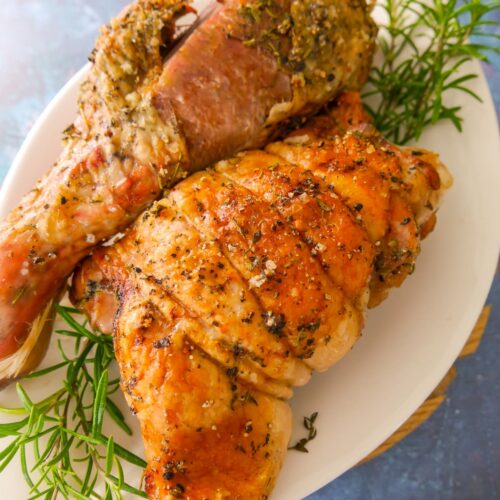
Slow Roast Turkey Leg
Slow roast turkey leg, if packed full of flavour and this results in great tasting turkey juices which make the best turkey gravy.
Print
Pin
Save
Servings: 2
Calories: 580kcal
Equipment
- chopping board
- Sharp kitchen knife
- Medium sized roasting dish large enough to hold the turkey drumstick and thigh
- Kitchen foil
Ingredients
Roast turkey
- 1.6 kg turkey leg (includes drumstick and thigh portions)
- 1 onion (roughly chopped)
- 2 carrots (roughly chopped)
- 2 stalks celery (roughly chopped)
- 1 bulb garlic (cut in half and lightly crushed)
- 4 sprigs rosemary (divided)
- 4 sprigs thyme (divided)
- 200 ml chicken stock or water
- 2 tablespoon olive oil
- 1 teaspoon sea salt (divided)
- 1 teaspoon black pepper (divided)
Turkey gravy
- strained off roast turkey juices
- 3 tablespoon cornflour
- 2 tablespoon water
- 450 ml turkey or chicken stock
- sea salt & black pepper (to taste)
Instructions
How to roast turkey leg
- Preheat the oven to 140CFan/160C/325F.
- Prepare the vegetables and garlic bulb and place in the bottom of the roasting dish, along with 2 sprigs of thyme, 2 of rosemary and the chicken stock or water.
- Roughly chop the remaining rosemary and thyme and add to the olive oil with the salt and pepper.
- Gently push back the skin on the turkey and rub some of the herby olive oil directly onto the skin. Pull the skin back over the meat and pour the remaining herb oil over the skin of both joints and rub all over.
- Place the turkey leg and thigh on top of the vegetables, cover with a layer of kitchen foil, and place the roasting dish into the hot oven for 2 hours. Turn the turkey legs midway through the cook.
- After 2 hours turn up the heat on the oven to 200CFan/220C/430F.
- Remove the kitchen foil and continue roasting the turkey for a further 20-25 minutes to crisp up the skin. By this point the turkey will be cooked. It should reach an internal temperature of 74C/165F at the thickest part.
- Remove the tray from the oven, cover the turkey loosely with foil and set aside to rest for 10 minutes.
- Once the turkey has rested for 10 minutes, remove onto a chopping board and keep covered with the foil. Rest the turkey for a further 10 minutes, while you make the gravy.
How to make turkey gravy
- Strain off the turkey cooking juices from the roasting pan into a jug or bowl. Leave to settle for a few minutes and then skim off any fat that has floated to the surface.
- Add the cornflour and water to a small bowl and mix to form a paste.
- Place the turkey juices into a saucepan, along with the turkey or chicken stock. Bring to a boil, then turn the heat down to medium.
- Pour the cornflour mixture into the saucepan, whisk to combine and remove any lumps, and gently heat up the gravy again until it has thickened. Taste the gravy check for seasoning, and adjust to taste.
- Pour into a warm gravy jug and serve.
Notes
- Cooking the turkey low and slow gives you the best flavor and lovely soft pieces of turkey which are fall off the bone tender.
- When cooked turkey should reach an internal temperature of 74C/165F at the thickest part. For ease, I like to use a meat probe thermometer to do this.
- If you don't have a thermometer, then simply insert a sharp knife into the thickest part of the turkey, remove the knife and gently press the incision to release the internal cooking juices. If the juices run clear the turkey is cooked, if they are pink the turkey needs longer to cook and you should return to the oven. Work up in 5 minute intervals until the meat is cooked through.
- When straining off the turkey cooking juices, I like to use a fat separator jug which makes things a lot easier. However, you can also use a regular jug or bowl and just skim off the fat with a spoon.
- When making the gravy, only season it at the end of the cook before serving. How much salt and pepper you add will depend on the stock you are using. I used my homemade chicken stock which I do not add any salt to. However, some store bought stocks can contain quite a bit of salt so I recommend tasting the gravy first and then seasoning to taste.
Nutrition Facts
Slow Roast Turkey Leg
Amount Per Serving
Calories 580
Calories from Fat 270
% Daily Value*
Fat 30g46%
Saturated Fat 7g44%
Polyunsaturated Fat 6g
Monounsaturated Fat 16g
Cholesterol 139mg46%
Sodium 1719mg75%
Potassium 1156mg33%
Carbohydrates 33g11%
Fiber 4g17%
Sugar 9g10%
Protein 44g88%
Vitamin A 10491IU210%
Vitamin C 13mg16%
Calcium 105mg11%
Iron 5mg28%
* Percent Daily Values are based on a 2000 calorie diet.
• Please note that the nutrition information provided above is approximate and meant as a guideline only •
Tried this recipe? We'd love to see your photos!Mention @lostinf00d or tag #lostinfood!
Share on Facebook